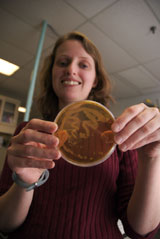Sara Walton
 A stump-dwelling, mustached, make-believe character taught me an early lesson about environmental responsibility. My favorite childhood book was The Lorax, a Dr. Seuss parable about the harm of exploiting natural resources. It stars a small yellow creature that “speaks for the trees, for trees have no tongues!” The little guy gets angry when the greedy Once-ler chops down all the Truffula Trees just to make trendy knit Thneeds. I’d like to think the Lorax would recognize the care we exercise in our research techniques at the University of Maine, and see that we “care a whole awful lot” about our impact on the forest!
A stump-dwelling, mustached, make-believe character taught me an early lesson about environmental responsibility. My favorite childhood book was The Lorax, a Dr. Seuss parable about the harm of exploiting natural resources. It stars a small yellow creature that “speaks for the trees, for trees have no tongues!” The little guy gets angry when the greedy Once-ler chops down all the Truffula Trees just to make trendy knit Thneeds. I’d like to think the Lorax would recognize the care we exercise in our research techniques at the University of Maine, and see that we “care a whole awful lot” about our impact on the forest!
My Research
I am separating the hemicellulose component of hardwood to produce a source of sugars for fermentation to ethanol. Woodchips are reacted in a rocking digester under alkaline conditions at high temperature and pressure, dissolving some of the hemicellulose into a dilute solution. This solution is concentrated using a thin film evaporator, then undergoes acid hydrolysis. The sulfate is removed through overliming with calcium hydroxide, creating gypsum that is filtered off. The resulting sugars also contain a high concentration of acetic acid, which must be removed. I will be looking at different methods for removing acetic acid, such as ion exchange resins. The final purified sugar solution will be fermented under different conditions in 3L bio-reactors, which have well regulated temperature, pH, agitation, and gas flow. Escherichia coli K011 is an engineered bacteria that is used in fermentation, consuming both five and six carbon sugars to produce ethanol as the primary product. HPLC analysis is used to monitor concentrations during fermentation, and together with on-line measurements of carbon dioxide and cell growth, is used to complete the fermentation mass balance.
In Other Words
I make fuel ethanol from wood! Wood is basically made from sugars which are linked together, and these bonds can be broken to release some of the sugar. Many organisms, such as the yeast used in baking and beer production, can eat sugar. Yeast make ethanol (like beer) and release carbon dioxide (this is what makes bread rise!). The yeast or bacteria can be improved to eat all of the sugars found in wood to make ethanol for fueling our cars. Organisms are sensitive to some of the chemicals used in this process, which can reduce how much ethanol they make. We are looking at ways to improve the process for getting sugar from wood and turning it into ethanol.
Click to view Sara’s resume
Contact Information
5737 Jenness Hall, Room 302
Orono, ME 04469
Phone: 207-581-2210
Email: Sara.walton@umit.maine.edu
